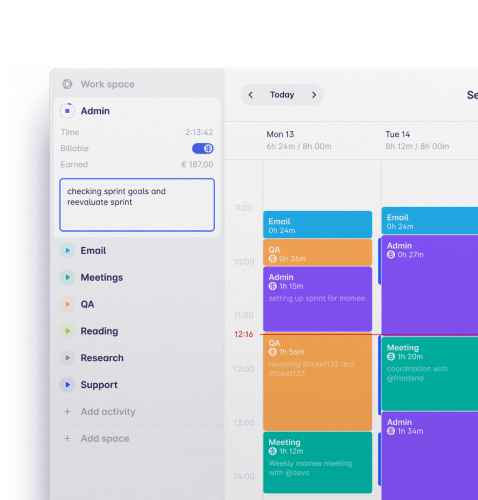How to overcome procrastination and stop putting things off
Procrastination: such a complicated word to describe something we do so easily.
We’ve all been there: we know we need to do a certain task, but we endlessly put off doing it. Then comes guilt, shame, and stress. We know that not organizing those files or tidying up the kitchen will have dire consequences, and yet we still don’t act on it.

Free eBook: How to work smart, not hard
Overcome procrastination and focus on activities which bring you the best results
Procrastinating is normal, and almost every human being experiences it at some point in their life. If you’re reading this, you’re already well on your way to solving it.
Seize that motivation and keep reading: we’ll cover a series of proven tricks and tactics to help you understand how to overcome procrastination.
How to overcome procrastination in 4 steps
1. Admit that you procrastinate
The first step to solving procrastination is to admit that you’re doing it. Procrastinators often live in denial that they put off their tasks, which only worsens the problem.
Accepting that you are a chronic procrastinator is the first step to stopping procrastinating, and it will allow you to get a clearer picture of your difficulties and map out a plan of action to overcome them.
2. Understand why you’re procrastinating
Have you ever noticed that you rarely procrastinate on fun and exciting tasks? That’s right, procrastination often lurks when we have something boring, stressful, or unpleasant to do.
Joseph Ferrari, psychology expert and author of “Still Procrastinating?: The No Regrets Guide to Getting It Done,” has an explanation.
He says that procrastination is explained by the inability to manage negative moods around a certain task. Low self-esteem is also a common reason.
When we postpone doing a task, we feel insecure about it’s common to find ourselves thinking: “I’ll never get this right”.

Free eBook: How to work smart, not hard
Overcome procrastination and focus on activities which bring you the best results
3. Define an action plan
What good is it to know that we procrastinate and understand why we do it, without defining a plan of action? But beware, we don’t mean just any plan.
You should try to set realistic goals and/or define a plan composed of SMART goals – Specific, Measurable, Attainable, Realistic, and Time-Oriented (If you’re struggling to do it, read our guide on how to set realistic goals).
“Tidying up the house” is too vague, and you’ll most likely look at the mess in the kitchen, the bed you need to make, and the bathroom you need to clean, and give up before you start.
Break down your plan into small measurable tasks like “Cleaning the fridge” or “Storing clean dishes” so you can go about crossing those tasks off your list. Also, make sure that your plan isn’t too ambitious and that you can actually stick to it so that frustration doesn’t set in.
Read also: Best scheduling apps for a small business in 2023

4. Evaluate and set rewards
Human beings are highly motivated by rewards. We like to receive them and to know that they are coming. By reward, we mean anything that motivates us or causes feelings of pleasure: it can be an object, a meal, an activity, etc.
According to Brain Facts, more than the reward itself, it’s actually the expectation of a reward that causes the most emotional reaction in the human brain.
So, one strategy that can help you overcome procrastination and do what you need to do is to create a reward system.
Giving yourself “free time” after tidying your room or “having dinner out” after a long day at work can be enough to motivate you! At the end of each task, evaluate the previously set plan and reward yourself in case you succeeded.
5 Ways to stop procrastinating
Now that we have the blueprint for starting to be more productive people let’s dig deeper into each of the steps outlined above and share 5 specific actions that will help you let go of inertia and move into action.
1. Use a time tracking app
Our main recommendation for you to stop procrastinating and become more productive is to gain a sense of what you’re doing with your time by using a time tracking app.
Procrastinators usually know that a whole day has gone by and they haven’t done what they needed to do, but realizing what a waste of time that is can be the turning point. After all, we all know it — time is money!
Using time management tools allows you to know exactly how much time you spend on each task and optimize it. Just start and stop the tracker as you go through each task. It’s as simple as that!

You need a simple, yet robust time tracking tool
Try Timeular which was recognized as the most user-friendly time tracking app for teams and individuals
2. Write to-do lists
Remember when we talked about the importance of setting a plan? Well, using a to-do list is one of the most effective ways to turn that plan into measurable actions.
Start your day by listing everything you have to do, breaking the day down into small tasks. This could apply to a day at work, a weekend, or even a holiday that you want to make the most of.
As you go through each task on your to-do list, you cross it off (and eventually give yourself the rewards we talked about earlier).
There are numerous benefits to using the to-do list method, including:
- Being a source of motivation, as you see progress happening;
- Providing a sense of accomplishment;
- Helping you manage your time as you know exactly where you stand and how long you have to finish;
- Reducing stress.
- Helping you become more organized and productive: the ultimate goal!

3. Prioritize
When we talk about time management techniques, it’s impossible not to mention the 4 Quadrants of Time Management Matrix.
Created by US President Dwight Eisenhower but popularised by Stephen Covey in his book The 7 Habits of Highly Effective People, one of the best productivity books, this method is highly effective.
Basically, there are 4 quadrants, which categorize each task according to its urgency and importance.
- Quadrant 1: Urgent and important
- Quadrant 2: Not urgent yet important
- Quadrant 3: Urgent but not important
- Quadrant 4: Not urgent and not important
Each quadrant is pretty self-explanatory, but if you want to know more about them, you might be interested in our blog about the 4 Quadrants of Time Management Matrix.

Free eBook: How to work smart, not hard
Overcome procrastination and focus on activities which bring you the best results
4. Try the “Eat The Frog” technique
American writer Mark Twain once said: “If it’s your job to eat a frog, it’s best to do it first thing in the morning.” While the prospect of eating a frog may be frightening to some people, Twain was actually using the metaphor that inspired the Eat The Frog technique.
According to the productivity, hack Eat The Frog, we all have an important task that we tend to put off — also known as the Frog.
Once identified, that task should be dispatched first thing in the morning (or first thing, whatever your favorite work hour is). That way, all our energy, and productivity will be directed towards “eating the frog” by first crossing the most difficult task off the to-do list.
This method is particularly useful for people who have difficulty prioritizing. If other more complex methods don’t work for you, for example, the 4 Quadrants of Time Management Matrix, start with this technique.
By identifying just one task to start with, you’re getting the most time-consuming thing out of the way and making progress on your to-do list.
Nowadays, there are various distractions during a workday like email, chat notifications, phone calls, etc. While you’re eating the frog and until you’re done, none of this should interfere.
5. Find the time management technique that works best for you
If you’ve only just embarked on a journey against procrastination, you may not be aware that there are dozens (if not hundreds!) of time management techniques. They all have the same goal — to make us more productive — but each of us has a favorite.
Do your research, try some, choose your favorite, and stick to it! Do you want another suggestion? The Pomodoro method.
No, your poor knowledge of Italian has not failed you. Pomodoro means tomato in Italian. And it was precisely the Italian student Francesco Cirillo who developed this technique in the 1980s.
Finding it difficult to study and complete his assignments, Cirillo used a tomato-shaped kitchen timer and committed to 25 minutes of uninterrupted concentration. And so the Pomodoro Technique was born (If you don’t want to use a physical timer, you can try one of the best Pomodoro apps). The steps that make up this method are as simple as it gets:
- Write down a to-do list;
- Set your timer for 25 minutes and choose a task to concentrate on;
- Work exclusively on that task until the time is up;
- At the end of the first 25 minutes, record your progress;
- Give yourself a five-minute break;
- Repeat the process until you have completed 4 pomodoros;
- After an hour, take a 15-30 minutes break.
Some extra considerations about the Pomodoro technique: if you have tasks that take less than a Pomodoro (25 minutes), group them with other small tasks.
You should only stop working when the alarm goes off. In addition, there should be no breaks during Pomodoros. Emails, group notifications, and phone calls can be answered at the end of your 25 minutes of productivity, so try your best to stick to it.
Easy, right? Now all you have to do is apply this hack to whatever you need for work, study, cleaning and tidying the house, etc.
Read also: If this technique doesn’t work for you, read our blog and get to know the greatest Pomodoro alternatives.
FAQs
What does procrastinate mean?
Procrastination is the voluntary act of putting off an action that needs to be done, even though one knows that there will be negative consequences. Usually, the action that the procrastinator postpones is unpleasant or tedious.
Is procrastination a mental illness?
Procrastination, itself, is not a mental illness or disorder. However, it is commonly interpreted as a symptom of certain mental disorders like ADHD, Depression, and Anxiety.
Is procrastination a sign of ADHD?
To date, no scientific study has demonstrated a direct link between Procrastination and ADHD. However, a common characteristic of people with ADHD is difficulty managing their time, which can lead to procrastination. There are several tips to stop ADHD procrastination, get to know them.
Are procrastination and laziness the same?
No. Procrastination and Laziness are neither the same nor the result of each other. Scientific studies have shown that we procrastinate due to poor mood management, not laziness, or poor time management.
Conclusion
It’s in our human nature: to put off as long as possible doing the things that cause us a bad feeling. However, procrastination has negative consequences, especially when it becomes chronic, and should be countered.
The tips and techniques we teach you in this guide against procrastination will definitely help you create healthier time management habits. Only one thing left to do: stop procrastinating and start applying them!
You might be interested in: